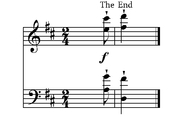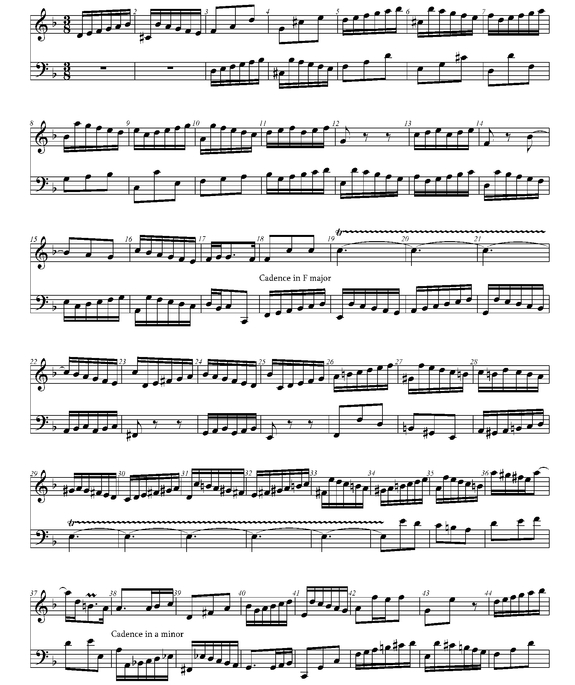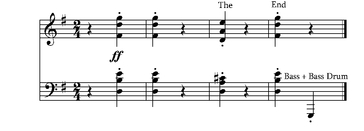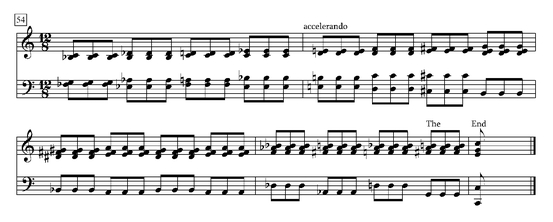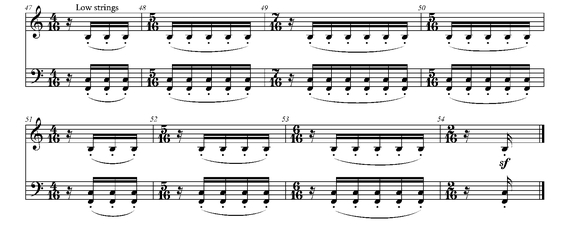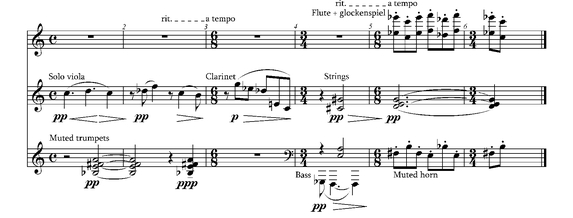4
Comma, Semicolon, Period
The Meaning of Cadence
If I see an ending I can work backwards.—ARTHUR MILLER
In chapter 3 we looked at the fundamental units of musical speech—motive, phrase, and period—as analogues for the fundamental units of verbal speech: word, clause, and phrase. In this chapter, we continue this grammatical analogy by looking at cadences as a musical form of punctuation. How do we know when a written sentence has ended? When we come to a period. How do we know when a musical sentence has ended? When we come to a cadence.
The Harvard Dictionary of Music defines the purely musical meaning of cadence as “A melodic or harmonic formula that occurs at the end of a section or a phrase conveying the impression of a momentary or permanent conclusion. Cadences are called ‘weak’ or ‘strong’ the more or less final the sensation they create.” When most people think of the term cadence, they think of what musicians call a perfect authentic cadence, the two-chord ending, dominant-tonic, that we saw Haydn wittily turn into a beginning in chapter 1.
EXAMPLE 21
However, there are many different kinds of cadences, and they do far more than simply end musical sentences. Cadences play as important a role in organizing musical structure as punctuation plays in organizing sentence structure. Without punctuation, both written and musical speech would turn into extended run-on sentences, and learning to listen for cadences and how they structure musical flow is vital to understanding musical grammar.
Comma, Semicolon, Period
Written speech offers a variety of ways to indicate weaker and stronger interruptions in the flow of a sentence. A comma indicates a relatively weak pause, a semicolon a stronger pause, and a colon a still stronger pause, with dashes and parentheses offering other mid-sentence options. Though a period is the standard sentence-ending punctuation mark, a question mark or an exclamation point can be used to convey a different kind of final feeling. Musical speech offers even more options for indicating weaker and stronger pauses than written speech, and different historical periods and musical styles use completely different cadence formulas. If we include medieval and Renaissance music in the discussion, we face a bewildering array of labels: double-leading tone cadences, Phrygian cadences, Landini cadences, suspension cadences, and anticipation cadences in addition to the more familiar eighteenth- and nineteenth-century authentic cadences, half cadences, imperfect cadences, deceptive cadences, and plagal cadences.
The good news for anyone who is not a music theorist or a musicologist is that there is absolutely no need for you to learn all of these cadence forms and names. What is important is for you to become sensitive to what spawned all these labels in the first place—the many different ways composers have used cadences to create musical punctuation, regulate musical flow, and “convey the impression of a momentary or permanent conclusion.” Let’s start with the most familiar eighteenth- and nineteenth-century cadences to hear how composers distinguish between different degrees of musical finality—between musical commas, semicolons, and periods—and see how these distinctions organize musical structure.
Comma
Here is the opening orchestral section of “Autumn” from Vivaldi’s Four Seasons.
EXAMPLE 22
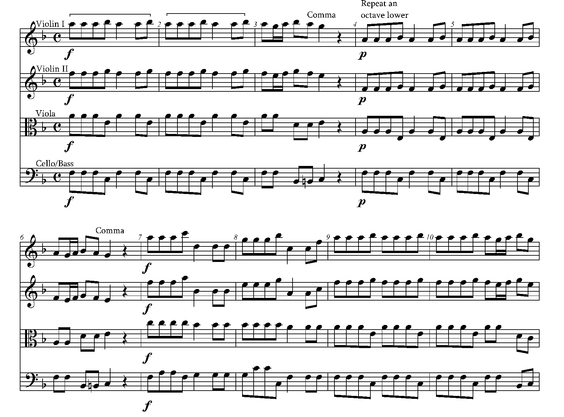
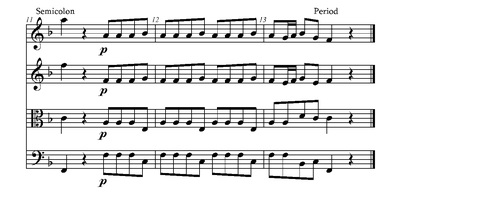
The first cadence is in measure 3, and like the one at the end of the first half of our “Fossils” example in chapter 3 is traditionally called a half cadence. It is the musical equivalent of a comma, the weakest, or least final, form of cadence, and clearly requires another clause of music for any real sense of finality. Note however, that though the cadence is inconclusive, the entire phrase is designed to lead to it and make it the “main event” of this opening sentence. The melody of measure 1, which is repeated in measure 2 (showing us that it is an idea), contains only two notes, A and B-flat, and these two notes are always harmonized by the same two basic chords. Much like the opening of “Spring,” which we looked at in chapter 2, the simplicity of this beginning makes the arrival of a new melody note in measure 3 (a G), accompanied by new, quick-changing chords that push to the cadence, a significant event. Listen to the example again and notice, even in this simple context, Vivaldi’s characteristic drive to the cadence. This cadence is more than just a mere punctuation mark providing a “momentary conclusion” to the phrase. Its meaning is inextricably bound up with the plot of the phrase as a whole. The cadence is given its sense of finality by the way the phrase moves toward it, while as end point and goal it gives meaning and shape to the entire phrase that precedes it. In much the same way, the daily noon-hour lunch break in a factory worker’s schedule not only marks a dividing point in the workday, but it also gives a direction to the hours from nine to twelve that push toward the lunch break—the day’s main structural event. (And the hours from nine to twelve usually have their own structure determined by “weaker cadences”—ten-minute coffee breaks.)
Semicolon/Period
As I mentioned earlier, it is not important as a listener that you be able to name the cadences you hear in music, but it is important that you be sensitive to how “final” they feel. If the half cadence in measure 3 is a musical comma, the stronger cadence that occurs in measure 11 is a kind of musical semicolon. This time the music resolves firmly to our home F-major chord, the central chord of the piece, but the resolution in the melody, to an A rather than an F, is not as final as it could be. (The sound is what is important, not the labels or names of notes.) Two measures later, however, the identical cadence figure returns an octave lower, and this time resolves the melody to an F, ending the entire opening section with a strong and final musical period.
There are two main points I want you to be aware of in this passage. First, listen to it again in its entirety and try to hear the different degrees of finality of the four cadences—musical commas in measures 3 and 6, a semicolon in measure 11, and a period in measure 13. Second, notice how these four cadences literally structure the entire opening, with each cadence clearly demarcating a gradual movement from something open-ended to something final: from comma, to semicolon, to period.
Deception and Delay
Because perfect authentic cadences are so final and convey an “impression of permanent conclusion” so strongly, composers frequently postpone their arrival to make them even more emphatic. In “Autumn,” Vivaldi delays his final section-ending cadence by preceding it with a slightly weaker cadence in which the melody avoids the tonic note. In his Piano Sonata in B-flat Major K. 333 (315c) (example 23), Wolfgang Amadeus Mozart subtly delays his section-ending cadence in measure 10 with two weaker, comma-like cadences, one in measure 6 and one in measure 8. In each of these cadences, the bass note (a D, not a B-flat) avoids the tonic note, making the cadence feel less final and less rooted. Delaying final resolution strengthens the cadence that ultimately ends the section and makes it feel even more conclusive.
In the same way that punctuation marks structure the flow of a written sentence, these cadences structure the flow of Mozart’s musical sentence. When the music refuses to resolve definitively at the first cadence, in measure 6, the motion speeds up. Mozart’s second try has more urgency. Measure 7 is a more intense version of measure 5, and the scale in measure 8 has enormous sweep compared to the scale in measure 6, leading to a powerful resolution at the final cadence, with the highest notes of the piece so far, at the loudest dynamic (forte), with double notes in the right hand. Once again, the cadence is given meaning by the way the section moves toward it, while this final cadence, as end point and goal, gives meaning and shape to the entire section that precedes it.
EXAMPLE 23
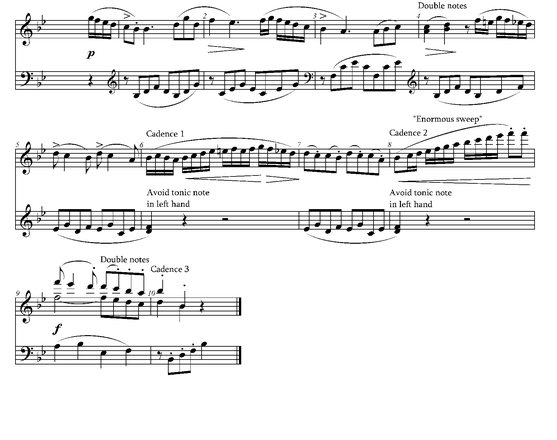
Cadences as powerfully final as the ones that end our Vivaldi and Mozart examples can have an enormous impact on the structure of a composition. In many Baroque pieces, where the musical flow tends to be continuous once a composition is under way, these cadence points, and the sense of arrival and “momentary conclusion” they provide, can literally determine the architecture of an entire piece. In Bach’s D Minor Two-part Invention, for example, three clearly audible, perfect authentic cadences—one in F major (measure 18), one in A minor (measure 38), and a final one in the home key of D minor in the last measure—organize the musical flow and define the structure of the whole composition. Each cadence point is the goal that its section heads toward and the first two cadences are also departure points for the new section that follows. This kind of overlap (a musical equivalent to enjambment in poetry), in which a cadence simultaneously ends one phrase while beginning the next, is one of the central ways composers create punctuation in musical sentences while still maintaining flow and continuity. A new melody begins at the same moment the harmony resolves. While the harmony goes “The End,” a new melody starts above “End.”
For Bach, these intermediate cadences are stopping points on a journey home to D minor. They function in Bach’s narrative like Odysseus’s sojourns at Circe’s island, Calypso’s island, and the Palace of Alcinous on his journey home to Ithaca. Because the invention’s final D-minor cadence is the fundamental goal and destination of the entire piece (Bach’s “Ithaca”), a dramatic extra cadence in measure 49, at what seems to be the moment of final resolution, is added. This is called a deceptive cadence because a chord is “deceptively” substituted for the expected D-minor chord, thereby making the actual cadence three measures later even more emphatic, satisfying, and final.
Once again, it is not learning the label “deceptive cadence” that is really important here, but rather that you hear the way a defining moment of musical punctuation—a final cadence—becomes more powerful through delay. Making musical events of various kinds more significant by delaying their arrival will be a topic we return to several times in this book, and as we shall see, scarcity not only increases the value of precious metals and natural resources, but it increases the value of musical resources, like a final tonic chord, as well.
EXAMPLE 24
One Hundred Years Later
It is, of course, not only music of the Baroque period that uses cadences to shape the structure of a piece. In a completely different musical style, with an updated harmonic language, Chopin’s E Minor Prelude from his 24 Preludes op. 28 functions almost identically to Bach’s invention, and neatly sums up nearly all of the points discussed in this chapter so far. On the most fundamental harmonic level, the entire prelude (one of the “Five Easy Pieces” played by Jack Nicholson’s character in the movie of the same name) is ultimately about getting to a decisive, final cadence on the piece’s home chord in its strongest form—an E-minor chord with an E in the bass. Like Bach’s invention, Chopin’s prelude only reaches its goal on the last chord of the piece, and the journey toward this chord structures the entire composition.
EXAMPLE 25
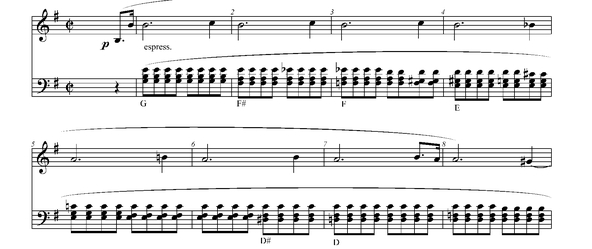
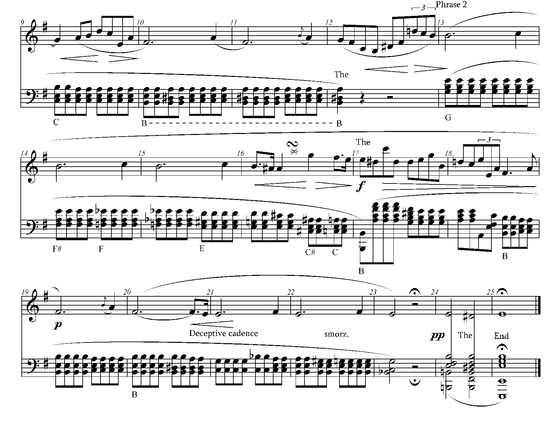
As we have already seen in chapter 1, a perfect authentic cadence (“The End”) is made up of two chords: a dominant chord (“The”) and a tonic chord (“End”). In the key of Chopin’s prelude, those two chords are a B chord and an E-minor chord. (Non-musicians should think of these names as labels and listen for their sound. Don’t worry about their technical makeup.) The entire first half of Chopin’s prelude, measures 1 through 12, is a gradual descent in the left hand toward “The”—a B chord. Though the passage’s heartbreaking, poignant chords seem to wander from key to key in an almost improvisatory fashion, if you listen closely to the bass line (the lowest left-hand notes), you can hear it move inexorably downward, always in the same eighth-note rhythm, step-by-step from the opening G down to B (G-F#-F-E-D#-D-C-B). The moment of arrival at measure 12 is clearly marked by the pause in the left hand and the elaborate decoration in the right hand, but though we have reached the dominant chord, the resolution to the tonic chord in measure 13 is not final. As in our Mozart example, it doesn’t include the tonic note (an E) in the bass, but rather a G. Remember, hearing the different degrees of finality of cadences—how conclusive or inconclusive they feel—is the point here. The inconclusiveness of this cadence keeps the plot going.
Measure 13 starts to repeat the opening, and, having read about antecedent-consequent phrases in chapter 3, we suddenly realize that, for Chopin, the entire first twelve measures are a single unit. Though the chords and the bass line of the second phrase are an exquisite variation of the first phrase, the second phrase also moves step-by-step in the left hand from G down to B (measures 13 through 17). Having reached our dominant chord a second time, we are now ready for final resolution, and Chopin spends four full measures (measures 17 through 20) preparing us for this defining moment. But as in Bach’s invention, instead of a resolution in measure 21 to E minor, we get a deceptive cadence. The three following measures take us to an utterly confusing, harmonically ambiguous pause in measure 23, where the piece simply stops dead. Just when it seems as if we will never find our way home to E minor, we finally get the cadence that we have been waiting for. With an almost surreal, textbook clarity and firmness, we finish with The End. The only perfect, authentic cadence in this entire prelude is saved till its very last measure.
Contemporary Music
I mentioned earlier that different historical periods and musical styles use completely different cadence formulas. One of the most important first steps for a listener encountering a new musical language is to get a feel for its cadences and punctuation, and this can be particularly challenging when dealing with twentieth- and twenty-first-century music. Mainstream concertgoers are generally familiar with the sound of the standard eighteenth- and nineteenth-century cadences even if they don’t know their exact names or grammatical makeup. However, in later music, there is an enormous variety of musical styles and few conventional, standardized cadential formulas. Composers have created their own forms of punctuation, which listeners must try to grasp piece by piece, often on a single hearing. Though there are far too many unique cadence forms in twentieth-and twenty-first-century music to generalize meaningfully about all of them, looking at a few brief examples of certain tendencies and recurring procedures can help train your ear and increase your ability to make sense of the many different kinds of musical punctuation this repertoire has to offer.
It is interesting that as twentieth-century composers began to invent sounds, colors, and harmonies unheard of in earlier music, they frequently held on in various ways to cadences from the past. The opening of the third movement of Maurice Ravel’s Piano Concerto, for example, is an almost literal updating of our Haydn string quartet opening from chapter 1 that wittily turned an ending into a beginning. The bass line of measures 3 and 4 has the same notes as a “The End” cadence would have had in a G-major Haydn string quartet, D-G, though the solo G (plus bass drum!) is humorously delayed until after the chord is played. However, both of the chords above this traditional bass line have extra notes dressing up an old Haydnesque cadence in modern clothes and giving it a fresh, contemporary feel.
EXAMPLE 26
Stravinsky dresses up the identical final cadence, in the same key, with different added notes to wittily begin The Soldier’s Tale. The first two dissonant measures make the mock-traditional cadence in measure 3 sound as if it is in quotation marks—a found object from the past, updated then inserted into Stravinsky’s neoclassical canvas.
EXAMPLE 27
Composers like Dmitri Shostakovich and Sergei Prokofiev frequently use decorated versions of “The End” to provide grounding and resolution at the end of harmonically ambiguous passages like this one from Prokofiev’s Peter and the Wolf.
EXAMPLE 28
Notice as you listen to this example the way the cadence at the end seems to clarify an otherwise confusing passage. Also notice that though the harmonic direction of the phrase seems unclear until the cadence, what gives it direction is the melody line, which ascends a half step at a time, ultimately from C to C. (A half step is the smallest distance possible on a piano between notes, the distance from any key to the next-nearest key, black or white.)
Many twentieth-century cadences keep the fundamental two-chord feeling and shape of “The End,” but change both the bass line and the chords above it. In the Sarabande from Ravel’s Pour le Piano, all of the chords in this final passage are non-traditional, built up with fourths, not the traditional thirds of tonal harmony. (Again, listen to the sound of these chords without worrying about their technical makeup.) Consequently, when we get to the penultimate chord of the movement (“The”), we do not have the normal expectations we have in a conventional cadence. We simply don’t know where the chord will resolve, but if we had to guess we would probably guess E major. When instead it resolves incredibly softly (pianississimo) to C# minor, the one traditional triad in the passage, it is a complete, though subtle, shock. Ravel creates his own unique, elegant, modal cadence that although utterly unexpected, sounds, in retrospect, completely inevitable. A dance form (the sarabande) and a cadence from the past are filtered through Ravel’s twentieth-century sensibility and emerge reinvented and new.
EXAMPLE 29
Atonal Music
Composers as diverse as Ravel, Shostakovich, Stravinsky, Benjamin Britten, Copland, and Béla Bartók created an entire repertoire of cadences like these that update traditional tonal formulas and infuse them with new life. However, some of the most interesting and challenging cadences for composer and listener alike are those designed to provide punctuation in contexts where the musical language is not tonal in any traditional sense. In the absence of conventional harmonic kinds of resolution, composers have had to find other ways of distinguishing between “momentary” and “permanent” conclusions. Often, it is pure gesture alone that lets us know a phrase has ended. The opening movement of Stravinsky’s twelve-tone composition Requiem Canticles, for example, arrives at the final cadence by brute force. The same dissonant chord is simply repeated thirty-one times in constantly shifting rhythmic patterns, and then after a short pause played one more time with a sharp accent. This final accented chord ends the piece, though there is no harmonic resolution, no change of chords, and no cadence in any traditional sense. The piece ends because Stravinsky says it does. We know it is over because there is no more music.
EXAMPLE 30
With equal will, though in less aggressive fashion, Anton von Webern essentially does just the opposite in the third movement of his atonal Six Pieces for Orchestra. He simply sustains a dissonant chord (measure 4) and allows it to die away until the listener has no choice but to accept the chord, dissonant though it may be, as a cadence—a “momentary conclusion.” (I will have much more to say about these kinds of endings in the final chapter,“Finished versus Complete.”)
EXAMPLE 31
Webern 6 PIECES FOR ORCHESTRA (1928 Revision)
© 1956 by Universal Edition A.G., Vienna Copyright renewed.
All Rights Reserved. Used by permission of European American Music LLC,
sole U.S. and Canadian agent for Universal Edition.
There is one more aspect of this passage that is relevant to a great deal of other contemporary music. Notice that after the cadence on the sustained chord in measure 4, the music picks up and starts a completely new musical idea, played by new instruments, in a new tempo, a new meter, and a new register. This complete contrast makes it clear retrospectively that the previous sustained chord has ended something. Very often in contemporary music a cadence is defined by the next music’s being different. Starting something new can let the listener know that we have finished the preceding phrase or section. Even if that something new is actually nothing—that is, a rest. In the first movement of Requiem Canticles, for example, several short phrases end with a measure of silence, and it is this silent measure that functions each time as a cadence and lets us know the phrase has ended. Similarly, in the minimalist music of Steve Reich, a single chord often lasts three to four minutes, and in the magical moment when the chord finally changes, we realize that the previous section has finished.
Cadere: To Fall
There are as many different kinds of cadences in contemporary music as there are composers, but before we conclude this chapter it seems appropriate, since it is the source of the term cadence itself, to glance quickly at punctuation and cadence in a kind of music that for many listeners is as foreign as contemporary music: medieval music. The word cadence actually comes from the Latin verb cadere,“to fall,” which referred to the way cadences were ordinarily made in the single-line world of medieval plainchant: by descending, or “falling,” to the final note.
EXAMPLE 32
Though the musical possibilities in this single-line universe of plainchant might seem to be limited, the subtle, varied, and deeply expressive use of cadences in this repertoire is extraordinary. The first five clauses of the beautiful Gregorian chant “Ave María,” have five different cadences that are “more or less final,”“weaker or stronger,” and “convey the impression of a more or less permanent conclusion” in the language of this single-line world with as much variety as the Bach, Vivaldi, and Mozart cadences we looked at earlier.
EXAMPLE 33
The opening invocation, “Ave María” (“Hail Mary”), literally “hails” Mary and calls us to attention with two striking leaps—a leap down on “Ave,” which prepares the huge (in the context of this spare, mostly stepwise melody) leap up, from D to A, on “rí” of “María.” Once you are inside this ancient musical language, the cadence is extraordinarily expressive. A simpler, more regular, and far less beautiful version might use one note for every syllable, like this: A-ve Ma-rí-a.
EXAMPLE 34
Compare my version to the example, which instead of simply leaping up to the high note to end the phrase, prepares the cadence with three notes on “rí” to gradually ease us into the cadence. This three-note melisma (singing more than one note on a single syllable is called a melisma) with its poignant half step movingly conveys in restrained fashion the emotion of the devout toward the Virgin Mary, while the extra, slightly higher decorative note “falls” to the cadence with a sigh. This cadence, though in a completely different style, is as inconclusive as Vivaldi’s opening cadence and similarly requires additional music for resolution. In the grammar of plainchant, it is a musical semicolon.
The second clause,“grátia pléna” (“full of grace”), is even less conclusive. A two-note melisma on “plé” eases us into the cadence, but we are still up “high” in pitch on our A, and the phrase lacks any kind of conclusive “fall” or descent into the cadence on “na.” This “momentary conclusion” is at most a musical comma.
The third cadence, on “Dóminus técum” (“God is with thee”), is striking. The vocal line is completely syllabic—five syllables, five notes—and the music literally “falls” into the cadence with a remarkable leap down of a fourth. Up to this point, the chant has gone from a seven-note phrase with one melisma to a six-note phrase with one melisma. This five-note phrase without a melisma—the most compressed and concentrated phrase so far—perfectly prepares the beautiful “benedicta tu in muliéribus” (“blessed art thou among women”). In the Latin sense of cadere, “to fall,” this long phrase cadences, or “falls,” gradually over fourteen notes to the home note, D. Its graceful descent is clear even visually. Everything contributes to the sense of arrival at the cadence. The phrase begins syllabically with “benedicta tu,” but then three two-note-per-syllable/one-note-per-syllable pairs (“i-n mu . . . l-i é . . . r-i bus”) ease us rhythmically into the cadence, and the arrival at D (on the syllable “é”) is stabilized and made more conclusive by the two D’s that follow.
Cadences
As we have seen, how composers punctuate their musical sentences has changed greatly over time. The techniques and cadences we find in the single-line world of plainchant are completely different from those we might find in a string quartet by Haydn, which are different from those we might find in a string quartet by Elliot Carter, or a symphonic work by György Ligeti, yet no matter the style or time period, musical sentences, like written sentences, require punctuation. Cadences are crucial because they demarcate events and provide landmarks that give structure to music, and this need to create structure seems to be an essential human trait operating outside of music as well. It was the original impulse behind the creation of the church calendar, which took a series of undifferentiated days and constructed a meaningfully punctuated year organized around two principal “cadences,” or feasts: the Nativity and Easter. The liturgical year leads to these pivotal events like a phrase leads to a cadence. Even our secular year (particularly the retail component) organizes itself around cadential landmarks—Labor Day, Halloween, Thanksgiving, Christmas, et cetera—with the periods preceding these holidays defined in relationship to each upcoming celebration. We also have personal structural markers that function like cadences. Baptisms, bar mitzvahs, confirmations, graduations, weddings, silver and gold wedding anniversaries, reunions, and the like. These cadences function much as they do in music, to structure and shape the flow of our lives. Not all endings, personally or musically, are of the same finality—finishing freshman year (a half cadence) is not the same thing as graduating from college (a perfect authentic cadence). Yet all of these endings give a rhythm and a shape to our experience, and learning to listen for that shape, in music as in life, starts with cadences.
